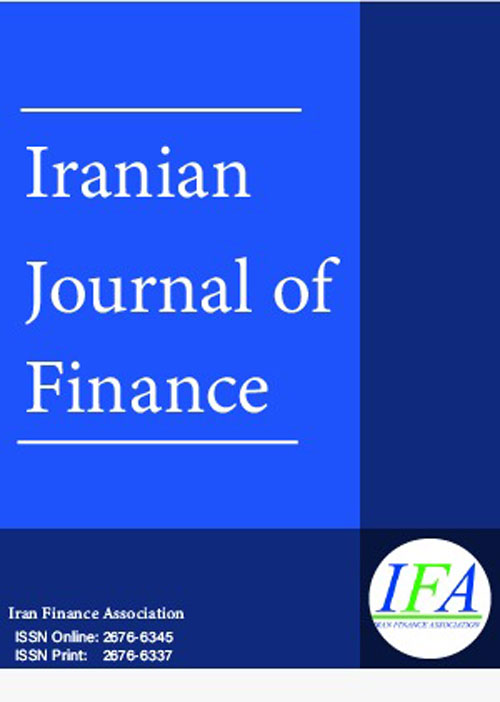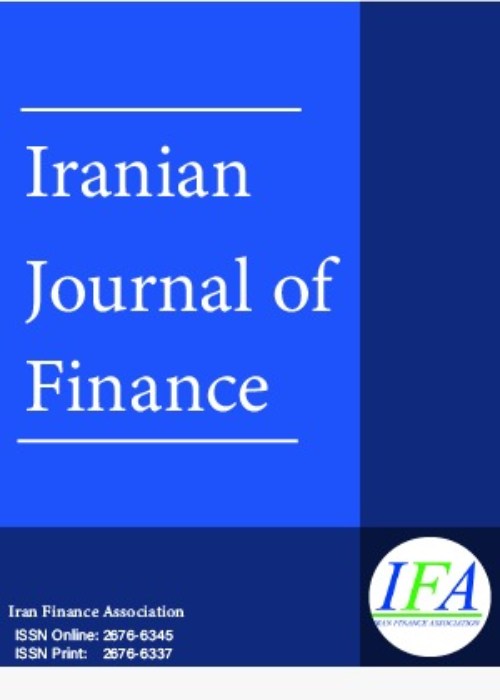فهرست مطالب

Iranian Journal of Finance
Volume:6 Issue: 1, Winter 2022
- تاریخ انتشار: 1401/02/12
- تعداد عناوین: 6
-
-
Pages 1-27The tremendous advances in artificial intelligence over the past decade have led to their increasing use in financial markets. In recent years a large number of investment companies and hedge funds have been implementing algorithmic and automated trading on their trading. The speed of decision-making and execution is the most important factor in the success of institutional and individual investors in capital markets. Algorithmic trading using machine learning methods has been able to improve the performance of investors by finding investment opportunities as well as time entry and exit of trading. The purpose of this study is to achieve a better portfolio performance by designing an intelligent and fully automated trading system that investors with the support of this system, in addition to finding the best opportunities in the market, can allocate resources optimally. The present study consists of four separate steps. Respectively, tuning the parameters of technical indicators, detecting the current market regime (trending or non-trending), issuing a definite signal (buy, sell or hold) from the indicators’ signals and finally portfolio rebalancing. These 4 steps respectively are performed using genetic algorithm, fuzzy logic, artificial neural network and conventional portfolio optimization model. The results show the complete superiority of the proposed model in achieving higher returns and less risk compared to the performance of the TEDPIX and other mutual funds in the same period.Keywords: portfolio optimization, Artificial intelligence, Algorithmic Trading, trading systems, Genetic Algorithm, Technical Analysis, Neural Network
-
Pages 28-53One of the characteristics of the financial market, especially the stock market, is the effects of behavioral factors and on other financial and non-financial markets. There are several factors that affect the return of a stock exchange. We can refer to political, socio-cultural, technological and finally economic factors. A stock market is an economic market in which securities are traded under specific rules and regulations. Accordingly, in this study, the effect of behavioral financial arguments and other financial markets on stock market returns based on quantitative analysis has been studied. This article tries to examine how exchange rates, gold, and oil as key factors of a model can explain fluctuations of the stock market index. so the effect of those variables on the stock market index in the period 2008 to the first six months of 2018 has been analyzed using the FIAPGARCH-X model. The results of the analysis show that the effect of exchange rates on the stock market fluctuations is greater than the other two factors. The results also indicate that there are asymmetric effects of increased returns on the stock market, which is consistent with behavioral bias in behavioral finance.Keywords: volatility spillover, Behavioral Finance, FIAPGARCH
-
Pages 54-82The management control system provides valuable information on the managers' needs at different levels of the organization. Today, with changes in the political, social and economic dimensions, the management control system in the public sector also needs to be changed and adapted to new conditions and use new tools to meet stakeholders’ needs. The purpose of this study is to provide a model to investigate the role of the management control system and increase accountability in the public sector administrations and companies. In this regard, the present study explores the role of functions of management accounting in improving the management control system in the public sector. For this purpose, data were collected through interviewing 13 experts in the field of the management control system and functions of management accounting and reviewing related texts, articles and books in this field, and their content was analyzed through grounded theory and content analysis method and MAXQDA 2021 software was used for data analysis in 1399. The findings of this study showed that a management control system, if it has the necessary tools, can play a key role in preventing corruption, increasing transparency and accountability, performance-based budgeting, and performance-based auditing. The existence of a management control system is necessary for any organization; such a system will help identify resource flow, help management in decision making, motivate employees, make decisions related to outsourcing and contracting, reduce service delivery time, and many other issues in organizations, and it will ultimately lead to optimally allocate resources, prevent corruption, and increase legitimacy, transparency and accountability, Therefore, the optimal use of management accounting in the management control system, improves the achievement of organizational goals and the effectiveness of programsKeywords: Management control system in public sector, Management Accounting, Management accounting Functions
-
Pages 83-116Researchers examined anomalies in the market to understand the market dimensions. Prior studies considered the effects of biases on momentum strategy. Stock liquidity as one of the risk factors for assets was also considered by researchers. The purpose of this study is to examine the role of stock liquidity in the separately and jointly effect of anchoring bias and the disposition effect on momentum profit. The population of this study consists of all companies listed on the Tehran Stock Exchange. Based on systematic election sampling this study covers 136 companies over the period of 2007-2020. In this study, the effect of disposition effect is calculated using the approach of Greenblatt and Han (2005) and Frazzini (2006) and the anchorage bias is calculated according to George and Hwang (2004). This study calculates momentum profits according to Jegadeesh and Titman (1993). To test the hypotheses, multivariate regressions and the five-factor model of Fama and French (2015) have been used. The results of this study show that the disposition effect in stocks with low liquidity increases momentum profit. In addition, anchoring bias in stocks with low liquidity leads to an increase the momentum profit. Findings of this study document that the interaction effect of anchoring bias and disposition effect, while reinforcing each other, is also associated with increasing in momentum profit. Finally, when anchoring bias and disposition effect reinforce each other, and stocks have low liquidity, they do not increase momentum profits.Keywords: Anchoring Bias, Disposition Effect, Stock Liquidity, Momentum Profit
-
Pages 117-141"Corporate governance" includes mechanisms to monitor CEO's performance to assure efficient decision adoption and maximize firm value. One of the most effective aspects of firm performance is the degree of risk-taking. This study investigates the relationship between CEO power and institutional ownership with risk-taking behavior of member firms of Tehran Stock Exchange and Iran Fara Bourse during 2010-2019 by utilizing quintile regression. According to the results, by the increase of CEO's power and the company's benefit from powerful managers, the company risk (total risk and systemic risk) will decrease. As a result, managers are eager to safeguard their reputation as expert decision-makers and, as a result, they try to reduce company risk. In addition, the existence of institutional ownership among the shareholders of the company will reduce the risk, which can be referred to in the agency theory. Also, if the impact of these two variables is considered together, the risk will increase significantly. This very fact reflects the exercise of the power and influence of institutional owners. As a result, large shareholders have a supervisory role in the discipline of managers, but despite their impact on the relationship between managers' power and corporate risk, they do not alter the main negative relationship.Keywords: CEO power, institutional ownership, Risk-Taking, Exercising influence, power
-
Pages 142-168The present study aimed to identify the most effective causes of conflict of interest by examination of accounting literature and expert consensus. Understanding these factors, using cognitive psychology theories, can lead to a model for reducing conflict of interests. The dignity of the audit profession depends on fair and proper professional judgment by auditors, and achieving this requires identification and controlling of the key factors affecting judgment and decision-making. When auditors intentionally or unintentionally accredit financial statements in line with the opinion of their employers, public interests and the auditing profession are at serious risk. Several factors that can categorize into seven categories of structure, community, culture, environment, personality, audit firm characteristic, and ethics and behavior are rooted in a conflict of interests. However, no comprehensive research examining all the above factors and identifying the most effective ones has been done so far. By reviewing the research literature, major and minor factors were identified in domestic and foreign sources. Ten expert auditors were selected by the snowball method and interviewed. The considered major and minor factors were selected from among the introduced factors, and a questionnaire was sent to the experts using the Fuzzy Delphi (Screening) method. The results of the above statistical analysis identified eighteen of the most prominent sub-criteria of the factors affecting conflict of interests and identified structural factors the highest rank in this classification, which was agreed by the experts.Keywords: conflict of interests, Deviant Decision-Making, Fuzzy Delphi


